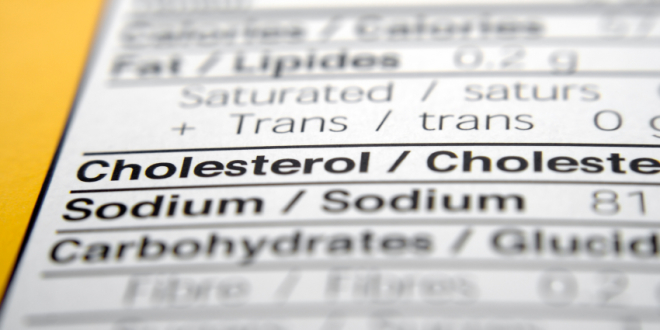by Michelle Sutton-Kerchner
September is National Cholesterol Education Month. The good, the bad, and the triglycerides. Let’s clear up any confusion …
Just the Facts, Please
The body needs cholesterol. It’s true! The liver generates cholesterol to produce cell membranes and hormones, aid digestion, and help the body fully function. However, the liver makes enough cholesterol on its own. Eating saturated fats causes the body to make excess LDL (bad) cholesterol. This excess can turn into artery-clogging plague that contributes to cardiovascular issues.
Cholesterol does not discriminate based on age. The American Heart Association asserts the cholesterol of average Americans is borderline high at 200 mg/dL. Numbers over 240 mg/dL double your risk of heart disease. Risk of heart disease can be present years prior to a cardiac event. The American Academy of Pediatrics recommends cholesterol screenings as young as nine years old. High cholesterol has been detected as early as preteen years.
Help children recognize, at an early age, the impact lifestyle has on their health. Emphasize proper nutrition’s importance on maintaining well-being rather than waist size. Youth does not guarantee health.
HDL, LDL, and unsure. Know your numbers and what they mean. With talk of good and bad cholesterol, and target numbers for each, you may need a translation:
- Good cholesterol measures high-density lipoprotein (HDL) level. Optimal HDL level: Higher is better. Individuals who regularly exercise have been known to achieve HDL values over 60, which lowers risk for coronary artery disease.
- Bad cholesterol measures low-density lipoprotein (LDL) level, Optimal LDL level: 100 mg/dL or lower.
- Optimal total cholesterol should be less than 180 mg/dL.

Other risk factors also must be considered to determine an individual’s heart health. Cholesterol levels are a significant part of a bigger picture. To determine your course of action, the combination of all risk factors must be considered.
Don’t forget about triglycerides. Triglycerides are another fatty-type substance found in the blood. They also are generated in the liver, and provide the body with energy. Excess levels are the result of lifestyle factors and genetics, just like cholesterol. High triglycerides often accompany high cholesterol levels. Optimal triglyceride level: 100 mg/dL or lower.
Silence isn’t golden. Symptoms are not usually present with high cholesterol. Like high blood pressure and diabetes, it is considered a silent condition that can lead to heart disease. Regular check-ups with your physician and routine screenings are essential in protecting your heart health. Health fair screenings are helpful indicators but should not substitute for a formal physical with blood tests. Know your risk factors and work to eliminate them.
Healthy cholesterol does not prevent heart disease. It does eliminate a significant risk factor for cardiac illnesses. However, other factors can contribute to heart disease, including genetics, body weight, blood pressure, diabetes, and lifestyle (Think: lack of exercise, cigarette smoking, weakness for bacon). Even if your cholesterol is good, both HDL and LDL numbers, you still need to monitor heart health for other conditions.
Medication is not the only treatment. According to research, adherence to a regular exercise routine can lower LDL cholesterol and raise HDL cholesterol.
Maintaining a healthy weight is only one of the ways exercise helps accomplish healthy cholesterol levels. Exercise helps burn fat found within the circulatory system, as well as body fat. It also can boost HDL cholesterol, and efficiently lower triglycerides. Therefore, along with a healthy low-fat diet, physicians usually advise exercise as the first course of treatment.

Dietary Recommendations:
- Enjoy a diet focused on fruits, vegetables, beans, and whole grains. Foods high in polyunsaturated fats and fiber can help lower cholesterol. Minimize red meat consumption and other high-fat foods.
- Avoid foods with saturated fat and trans fatty acids, which especially contribute to LDL cholesterol.
- Speak with your healthcare practitioner about possible supplements, such as fish oil which is proven to help lower triglycerides and benefit cholesterol numbers. Although their effect is often modest, combined with other lifestyle changes, they may do the job.

Exercise Recommendations:
- A cholesterol-lowering fitness program should include at least 40 minutes of moderate exercise, at least three times a week. Daily workouts, and longer durations, earn even more efficient results. Reaching the 40-minute length was more important than exercise intensity, according to a study from the University of Tokyo.
- With approval from your physician, be sure to achieve your target heart rate during exercise. Target heart rate should be between 60 and 80 percent of your maximum heart rate, for the most impressive results. A personal trainer, Group Fitness instructor, or on-site nurse can help determine your target heart-rate zone. They also can advise on safe, effective aerobic exercises to help you reach your goals.
- Consider aquatic exercise, give the elliptical equipment your best, or investigate an interesting Group Fitness class. (See the Center’s website for the latest Group Fitness schedule.) Weight training is also valuable and can complement the cardio aspect of your workout.
- Find activity you enjoy and engage in it. This will make it easier to remain committed and quicker to accomplish results. Remember, it doesn’t have to be a high-intensity kickboxing class or power session. Until you’re ready!
Know your risk factors for heart disease, including cholesterol levels. With your physician, determine a blood-screening schedule that is appropriate for you. Discuss results with him/her and share them with Center staff. With guidance, you can accomplish healthy cholesterol levels and clarify any confusion along the way. There aren’t any excuses for ignoring this common issue.
Sources
“Common Myths Surrounding High Cholesterol,” by Jennifer Moll at www.about.com.
“The Basics: How Exercise Can Help Improve Cholesterol Levels,” by Lia Tremblay at www.about.com.
www.cdc.gov.
www.heart.org.
Image Credits
Almonds and walnuts: www.flickr.com/photos/artbystevejohnson/4787368580/
 Fitness & Wellness News Your Source for Fitness News, Wellness News, Health News, and Nutrition News!
Fitness & Wellness News Your Source for Fitness News, Wellness News, Health News, and Nutrition News!




